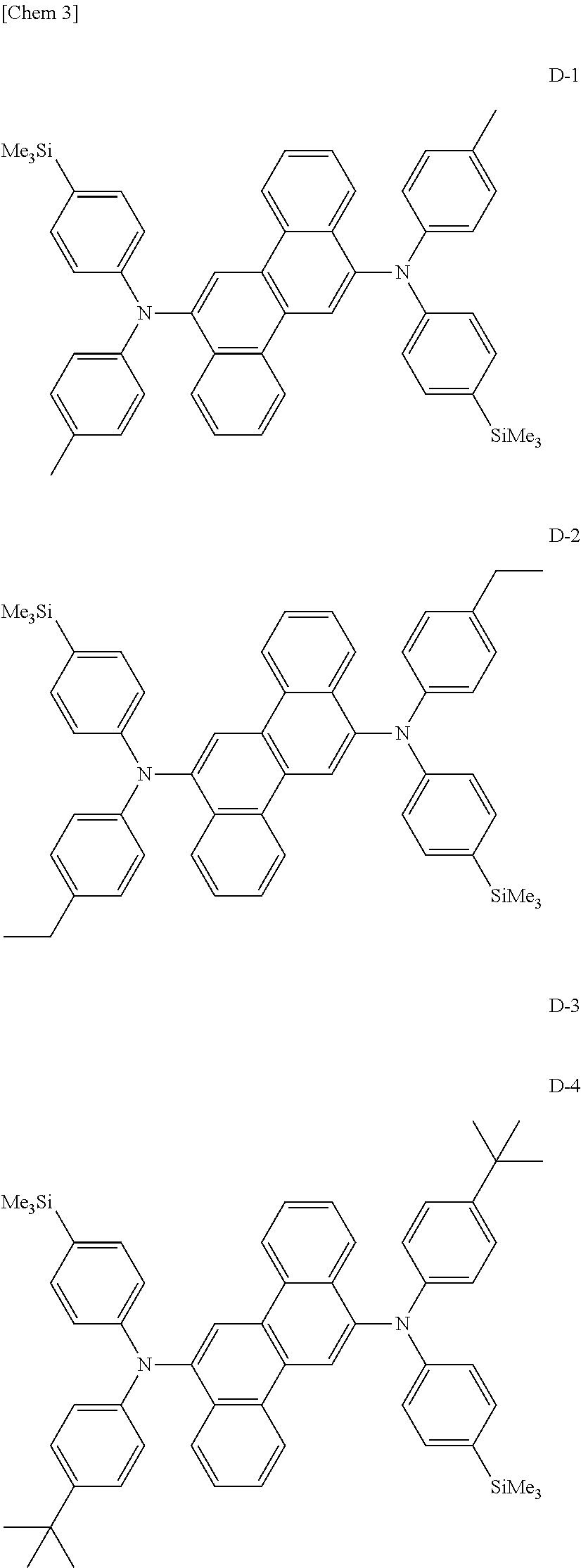Aromatic diamine derivative and organic electroluminescent device using the same
an organic electroluminescent device and diamine derivative technology, applied in the direction of triarylamine dyes, perylene derivatives, anthracene dyes, etc., can solve the problems of device not being put into practical use, device properties deteriorating remarkably, etc., to improve film formability, improve luminous efficiency, the effect of hardly deteriorating
- Summary
- Abstract
- Description
- Claims
- Application Information
AI Technical Summary
Benefits of technology
Problems solved by technology
Method used
Image
Examples
synthesis example 1
Synthesis of Compound (D-1)
[0115]In a stream of argon, 3.8 g (10 mmol) of 6,12-dibromochrysene, 6.4 g (25 mmol) of N-[4-(trimethylsilyl)phenyl]-N-p-tolylamine, 0.03 g (1.5 mol %) of palladium acetate, 0.06 g (3 mol %) of tri-t-butylphosphine, 2.4 g (25 mmol) of sodium t-butoxide, and 100 mL of dry toluene were loaded into a 300-mL three-necked flask with a cooling tube, and the mixture was stirred under heating at 100° C. overnight. After the completion of the reaction, the precipitated crystal was taken by filtration, and was then washed with 50 mL of toluene and 100 mL of methanol. Thus, 6.0 g of a pale yellow powder were obtained. The resultant powder was identified as Compound (D-1) described above because field desorption mass spectrometry (FD-MS) confirmed that the powder had a ratio m / e of 734.
synthesis example 2
Synthesis of Compound (D-2)
[0116]Synthesis was performed in the same manner as in Synthesis Example 1 except that N-[4-(trimethylsilyl)phenyl]-N-4-ethylphenylamine was used instead of N-[4-(trimethylsilyl)phenyl]-N-p-tolylamine in Synthesis Example 1. The resultant powder was identified as Compound (D-2) described above because FD-MS confirmed that the powder had a ratio m / e of 762.
synthesis example 3
Synthesis of Compound (D-3)
[0117]Synthesis was performed in the same manner as in Synthesis Example 1 except that N-[4-(trimethylsilyl)phenyl]-N-4-isopropylphenylamine was used instead of N-[4-(trimethylsilyl)phenyl]-N-p-tolylamine in Synthesis Example 1. The resultant powder was identified as Compound (D-3) described above because FD-MS confirmed that the powder had a ratio m / e of 790.
PUM
| Property | Measurement | Unit |
|---|---|---|
| current density | aaaaa | aaaaa |
| luminance | aaaaa | aaaaa |
| work function | aaaaa | aaaaa |
Abstract
Description
Claims
Application Information
 Login to View More
Login to View More - R&D
- Intellectual Property
- Life Sciences
- Materials
- Tech Scout
- Unparalleled Data Quality
- Higher Quality Content
- 60% Fewer Hallucinations
Browse by: Latest US Patents, China's latest patents, Technical Efficacy Thesaurus, Application Domain, Technology Topic, Popular Technical Reports.
© 2025 PatSnap. All rights reserved.Legal|Privacy policy|Modern Slavery Act Transparency Statement|Sitemap|About US| Contact US: help@patsnap.com



